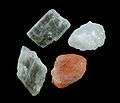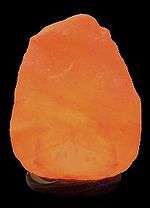Himalayan salt

Himalayan salt is rock salt or halite from the Punjab region of Pakistan. It is mined at the Khewra Salt Mine in Khewra, Jhelum District, Punjab, which is situated in the foothills of the Salt Range hill system in the Punjab province of the Indo-Gangetic Plain. It is located approximately 190 miles (310 km) from the Himalayas, 160 miles (260 km) from Lahore, and 185 miles (298 km) from Amritsar, India.[1]
Mineral composition
Himalayan salt is chemically similar to table salt plus mineral impurities. It consists of 95-98% sodium chloride, 2-4% polyhalite (potassium, calcium, magnesium, sulfur, oxygen, hydrogen), 0.01% fluoride, 0.01% iodine, and small amounts of numerous trace minerals.[2][3]
The salt crystals have an off-white to transparent color while impurities in some veins of salt give it a pink, reddish, or beef red color.[4] The reddish color is due to the presence of elements in polyhalite and trace minerals.[5]
-

Himalayan salt crystals
-

Salt from Khewra Salt Mine in Pakistan
Uses
Cooking
It is commonly used in cooking, in place of other table salt, in brine.[2] Numerous claims have been made concerning ingestion of himalayan salt, but there is no scientific evidence that proves it provides more health benefits compared to common table salt.
Blocks of salt are also used as serving dishes and in the preparation of food. Fish and some meats can be preserved for use in certain dishes, and blocks of salt can be slowly heated to a temperature of around 200 °C (392 °F) and used as a cooking surface thereafter.
Bath salts
It is sometimes used in bath salts.[2]
Salt lamps

A salt lamp consists of a large salt crystal, often colored, and lit with an incandescent light bulb, LED, or candle inside. Most of such lamps on the market are made of coloured salt rocks mined in Poland (Kopalnia Soli Kłodawa), Pakistan (the area of Kashmir), and Iran (Esfahan).
The lamps give an attractive glow and are suitable for use as nightlights or for ambient mood lighting.
Numerous claims have been made concerning salt lamps, but there is no scientific evidence that prove these beliefs or benefits.[6][7]
- no proof of air cleaning
- no proof of medical benefits
- no proof of ions emitted
- no proof of positive energy waves
- no proof of neutralizing electromagnetic radiation
See also
References
- ↑ Weller, J. Marvyn. "The Cenozoic History of the Northwest Punjab, in The Journal of Geology, Vol. 36, No. 4 (May–June 1928), pp. 362–375". jstor.org. Chicago Journals. Retrieved 24 February 2015.
- 1 2 3 "Himalayan Bath Salts – True Health Benefits or Marketing Hype?". OrganicSkinHerbsOnline.com. 13 October 2013. Retrieved 18 December 2013.
- ↑ Minerals in Himalayan Pink Salt: Spectral Analysis; The Meadow.
- ↑ Khewra Salt Mines; Pakistan Mineral Development Corporation.
- ↑ Freeman, Shanna. "How Salt Works". HowStuffWorks. InfoSpace LLC. Retrieved Oct 20, 2014.
- ↑ Lisa Berger. "Salt Lamps - Is it a Scam?". Today in Alternative Medicine. Retrieved 2012-10-23.
- ↑ Are Himalayan Salt Lamps Worthwhile?; Dr Weil.